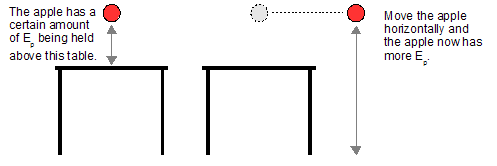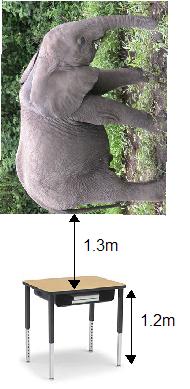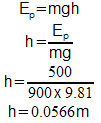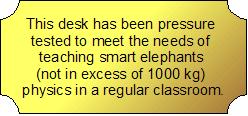Potential energy is a concept that you have already studied a few times in previous courses. You were probably given the standard definition...
Potential energy is stored energy that is able to do work later.
This means that potential energy can be found in many different forms:
- A car battery is storing energy in the chemical bonds between the substances inside. This is chemical potential energy.
- An elastic that you stretch to shoot at a classmate across the room has energy stored in it as elastic potential energy.
- Matter itself is actually energy in a stable, stored form. This is what Einstein's famous E = mc2 formula shows us, and is the basis for the release of energy from nuclear reactions like fission and fusion. It is sometimes called the rest mass potential energy.
- An object held up in the air is a form of stored energy, since as soon as it is released it will start to fall. It could do work because of this release of energy. This particular kind of potential energy is the main topic of this lesson and is called gravitational potential energy.
The formula for gravitational potential energy is quite simple and well known.
Ep = mgh
Ep = gravitational potential energy (J)
m = mass (kg)
g = gravity (m/s2)
h = height (m)
In the formula watch out how you use the variables.
- “m” is the mass of the object being held up. If an apple is being held above the ground, use the mass of the apple in your calculations, not the earth’s mass. Any mass can have gravitational potential energy, even if it's a tiny little single electron!
- “g” is the acceleration due to gravity. Since we will most often be doing questions that relate to earth you can use 9.81m/s2, but every so often questions will appear that are not on earth. Make sure to use the appropriate value if that's the case.
- “h” is the height of the object above some reference point, which should be whatever the object will hit if it is dropped. If you’re holding an apple above a table, don’t use the earth as a reference point, use the table top.
The weird part about the height of the object is that you can change the gravitational potential energy of an object by moving it horizontally (no change in its actual vertical position) because of reference points.

- We are not creating energy when we do this.
- Instead, we are just changing the proportion of Ep compared to other forms of energy by changing the reference point we are using.
- In the first case we used the table as a reference point, and in the second we used the ground. If you change the reference point, then you must start at the beginning and recalculate everything.
- This is similar to when we were talking about relative velocities in Lesson 9. Different observers may measure different velocities for the same object, and they are all correct.

Example 1: Determine the gravitational potential energy of a 900 kg elephant held 1.3 m above a desk that is 1.2 m high, as shown in the completely realistic and undoctored photo to the right.
I think we should not use the desk top as the reference point here, since the chances of it supporting an elephant are slim. Instead, we should consider the elephant to be 2.5 m above the reference point of the floor.
Ep = mgh
= (900)(9.81)(2.5)
Ep = 2.2e4 JIf we were told that the desk is made out of titanium and has been verified by the manufacturer as being able to support the full mass of up to a 1000 kg elephant studying physics, then we could use the desk top as our reference point.
Ep = mgh
= (900)(9.81)(1.3)
Ep = 1.1e4 J
In this example you get two different (but both correct) answers for the gravitational potential energy of the elephant.
- This is simply because different reference points have been chosen.
- In most questions you won't have to try to figure out the reference point based on information like in this example. You will simply be given the height above a certain reference point and that is all there is to it.
Example 2: Determine how high above the ground the elephant (from the previous example) is if he has 500 J of gravitational potential energy.

